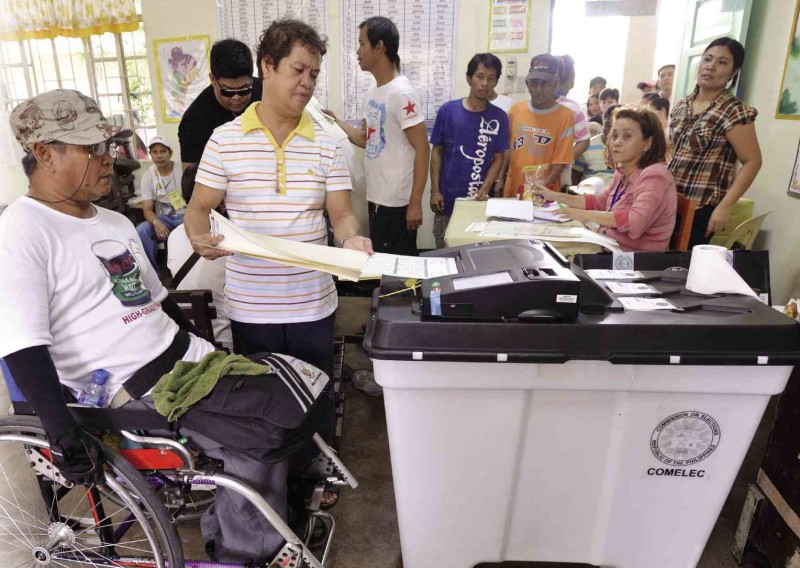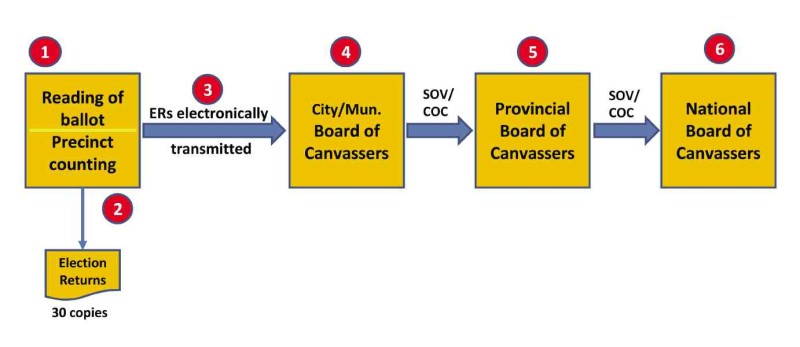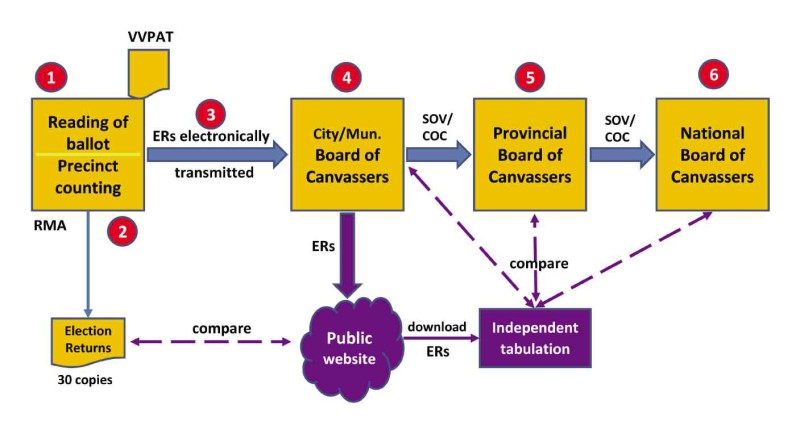Want your vote to be counted?

2013 ELECTIONS A teacher helps a disabled from Tahanan ng Walang Hagdan put his ballot sheet in a vote-counting machine at Marick Elementary School in Cainta, Rizal. AUGUST DE LA CRUZ
THE JOKE has been told often enough that in the Philippines no election candidate loses and those who don’t win must have been cheated. The first part of this “tongue in cheek” statement is of course untrue because many of them do lose. But the second part of the statement is so true—quite a number of candidates get cheated.
When Philippine elections were still manual, protests would be filed by losing candidates after the elections for various reasons. They would claim that, among other things, there was:
Article continues after this advertisementMisreading of the votes by the teachers
Miscounting of the votes
Stuffing of ballot boxes
Article continues after this advertisementSnatching of ballot boxes and their replacement with prefilled ballots
Erroneous consolidation at the municipal and provincial canvassing levels
Padding and shaving of votes, or the very infamous “dagdag-bawas” in which votes for some candidates would be reduced and the sum of which would then be added to the votes of the favored candidate.
Many protests unresolved
Some of these protests succeeded, although many did not. Even those which succeeded would usually be decided just a few weeks or even just a few days before the end of the term. So unfair.
If it takes years before protests at the local level are resolved, it takes even longer for those at the congressional, senatorial and presidential contests. Many just become moot, as the terms would have ended anyway.
And so, the Philippines took the bold step of automating elections. Chosen was the OMR (optical mark recognition) technology, where names of candidates are preprinted and the voters’ choices indicated by marking the corresponding ovals beside the names.
Promise
The move held the promise of not only cutting down the process by weeks but also eliminating cheating.
The Commission on Elections (Comelec), some congressmen and leaders of a citizens’ arm, who all sounded like they were salesmen of the winning bidder, explained that there would no longer be misreading of ballots, no more miscounting, no more ballot-box stuffing and snatching, and no more dagdag-bawas. There will be no human intervention as though it was an evil thing.
The automation covered two separate processes—the precinct count optical scan (PCOS) for the precinct counting, and laptops and PC servers for the canvassing and consolidation. This decision, by itself, defied logic. Precinct counting took only 5 to 12 hours in manual elections, yet we spent P11 billion to automate it, thus cutting down the time to a few minutes.
Transparency lost
Canvassing and consolidation, on the other hand, used to take some five weeks, but it cost the country only P300 million to cut down the time to five days or less. Worse, by automating the precinct counting, transparency was lost.
But except for saving on time, the pronouncements of the proponents of automation were so wrong! Cheating became easier because it can be automated. Unfortunately, except for the few instances that cheating was discovered, it had been difficult to prove its occurrence because of the absence of transparency in the system. The protest process has truly been seriously impaired.
Where cheating can occur
There are six areas where cheating can occur in automated elections. Not included are those external to the system, like vote-buying and flying voters. Let me discuss each of these. (See Figure 1.)
1. Reading of the ballot
Through malicious software, the marks on the ballots can be read and then interpreted incorrectly to favor some candidates. But even if there is no bad intention, there is the possibility that due to some defect in the machine, the votes could be read and interpreted incorrectly.
The VVPAT (voter verifiable paper audit trail), more popularly referred to as “receipt,” is an effective way of mitigating the impact of this weakness. It is not a 100-percent solution but at least the voters would feel that their votes were read correctly.
2. Counting of the votes at the precincts
Having read the votes correctly does not mean that the counting was accurate. The latter is a different step altogether. In fact, PCOS counting is the weakest point in the entire automated election system because nobody sees it done and there is no way of verifying its accuracy.
When precinct counting is automated, transparency is lost. For this reason, countries like Germany, The Netherlands, Ireland, Australia and about a dozen other countries reverted to manual precinct counting. They want the voters to see and understand how their votes are counted.
The way it’s done now is like handing over the ballots to Smartmatic and asking it to do the counting—instead of the teachers—inside a locked room. After it is done with the counting, Smartmatic slips the results out to the teachers. What this means is that foreigners would have done the counting in our elections. Is that acceptable to us Filipinos? That was so in 2010 and 2013. And it will happen again in May.
Is PCOS counting the same as what was just described? Yes, because PCOS is run by software. And who wrote the software? Smartmatic (Dominion Voting Systems of Canada in 2010 and 2013). It could have counted correctly, or incorrectly. The results could have been tampered with intentionally or unintentionally. And the really bad thing is that we won’t even know unlike manual precinct counting where the counting is done in front of us.
This weakness is partly mitigated by the source code review—restricted as it was—and the random manual audit (RMA). The RMA was poorly implemented in the last two elections but happily it will now be done by a different group and closely observed by the National Citizens’ Movement for Free Elections.
3. Electronic transmission of precinct results (election returns, or ERs) to the city/municipal boards of canvassers (C/MBOC)
It is possible to block the ERs during transmission and to alter the data before releasing them to their destination, the C/MBOCs.
Mitigation will be discussed after the next three canvassing steps.
4, 5 and 6. Canvassing and consolidation at the municipal, provincial and national levels, respectively.
It is in canvassing that dagdag-bawas, the deadliest among the cheating schemes, occurs.
Sadly, it is much easier to execute dagdag-bawas in automated elections. All one needs is to convince a small group of insiders, who knows the software, to modify it in order to favor some candidates. Many IT practitioners strongly suspect that this might have happened during the 2013 senatorial elections.
Post ERs on website
There is one simple step that will eliminate the vulnerability to cheating in the last four areas where such cheating can occur—post all ERs received by the C/MBOCs on a publicly accessible website. (See Figure 2.)
That single step will do two things:
The ERs viewed from the website can be compared with the printed ERs distributed to the political parties at the precincts. If the figures match, then we can be certain that no tampering occurred during transmission.
All the ERs on the website can be downloaded and independent tabulations can then be done by anybody in order that he can check the accuracy of canvassing at the municipal, provincial and national levels.
Attempts to tamper with the data during transmission and to rig the canvassing and consolidation would therefore be detected.
Comelec decision
Comelec Chair Andres Bautista announced during the Feb. 16 hearing of the Joint Congressional Oversight Committee that the Comelec would implement this recommended step. This, to many analysts, was the best and most significant decision the Comelec has ever made.
But during the March 23 hearing, Comelec Commissioner Christian Robert Lim said that the data to be posted on the public website would come from the central server. That decision just doesn’t make sense.
The copies of the ERs at the C/MBOC are what need to be audited because those are the official ones.
There is no assurance that the data in the central server would be the same as those in the C/MBOC, like what happened in the 2010 and 2013 elections.
9 percent and 23 percent of the PCOS machines failed to transmit the ERs in 2010 and 2013, respectively.
Apparently, the teachers in those precincts physically brought the compact flash (CF) cards to the C/MBOCs, where the CF cards were fed into the spare PCOS machines, thus completing the data. It is very possible that the central server and transparency server were not updated with those data.
Another disturbing news is that what the Comelec plans to post on the website are not precinct-level results, which means the figures would already be the result of consolidation, not raw data. They can already be corrupted! If this what the Comelec will do, then it’s next to useless.
For the sake of credible and transparent elections, and for the sake of our democracy, the Comelec must implement this step and implement it properly.
(Gus Lagman, a former commissioner of the Commission on Elections, is president of Automobile Association Philippines.)


















